An Analysis of Sustainable and Responsible Tourism in Kenya
VerifiedAdded on 2022/12/27
|15
|4144
|2
Report
AI Summary
This report provides a comprehensive analysis of sustainable and responsible tourism management, focusing on Kenya as a case study. It begins with an introduction to the concept of sustainable tourism, tracing its evolution and significance, and then delves into the roles, missions, and functions of leading global companies such as UNWTO and ABTA in promoting sustainable and accountable tourism. The report further explores the principles and purposes of tourism development and planning aimed at mitigating adverse environmental and social impacts, evaluating the associated processes, challenges, and problems. It examines the impacts of tourism activities from environmental, social, economic, and cultural perspectives, and analyzes how sustainability principles are implemented to meet stakeholder expectations. Finally, the report assesses the creation and management of sustainability in various tourist destinations worldwide, critically examining the successes and failures of sustainable management practices.
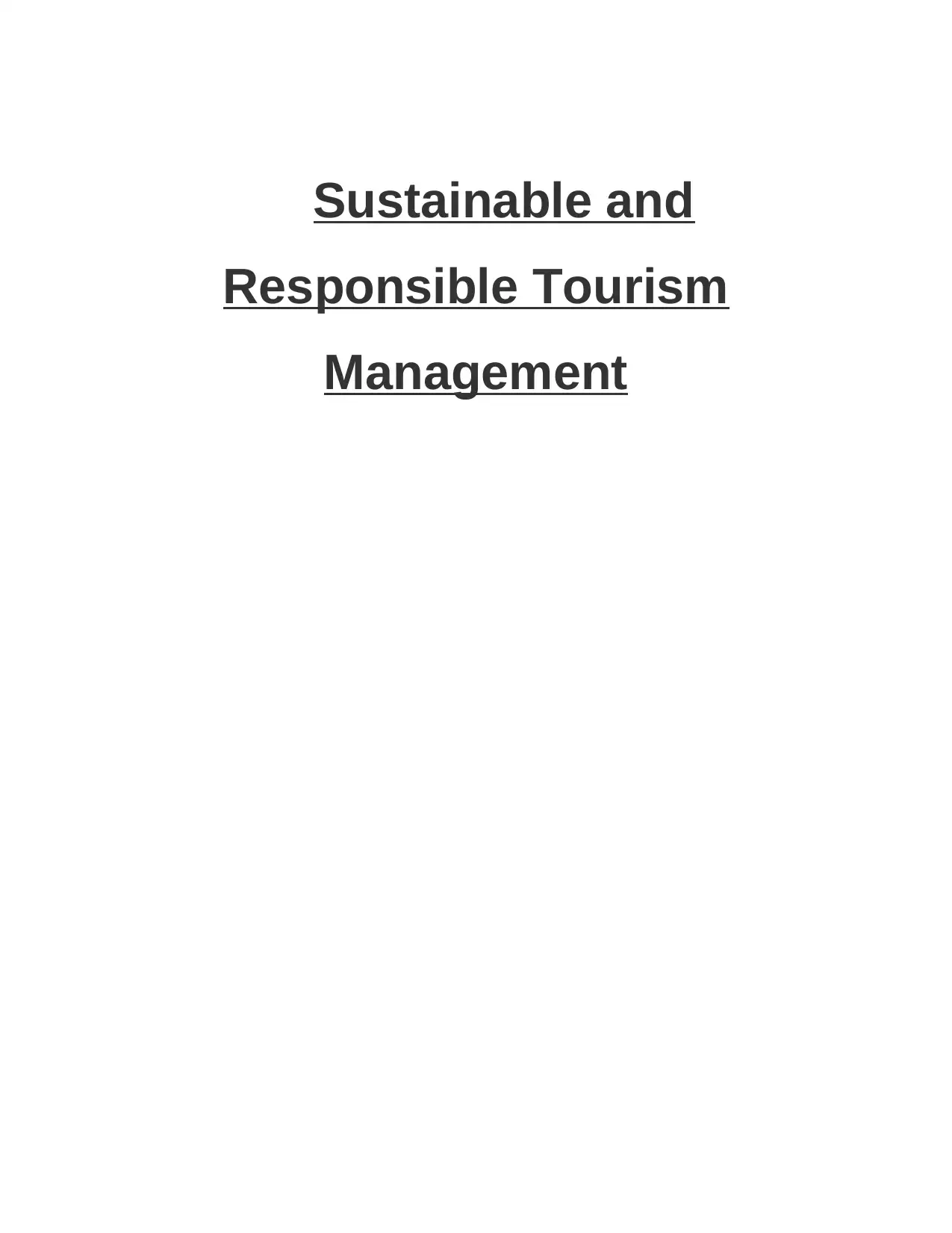
Sustainable and
Responsible Tourism
Management
Responsible Tourism
Management
Paraphrase This Document
Need a fresh take? Get an instant paraphrase of this document with our AI Paraphraser

Table of Contents
INTRODUCTION...............................................................................................................4
MAIN BODY.......................................................................................................................4
LO 1...................................................................................................................................4
P1 Explaining evolution of sustainable & responsible tourism......................................4
P2 Role, mission and function of leading global companies in context of promoting
sustainable and responsible tourism.............................................................................5
M1 Analysing meaning and concept of sustainable & responsible tourism according
to leading international companies................................................................................7
LO 2...................................................................................................................................7
P3 Explaining the principles and purpose of tourism development & planning to
decrease adverse effects of tourism.............................................................................7
P4 Evaluating procedure of tourism development and planning and associated
problems as well as challenges.....................................................................................9
M2 Critically evaluating varied approaches to tourism development and planning for
successfully achieving sustainable objectives............................................................10
LO 3.................................................................................................................................10
P5 Investigating impact of tourism activity generate by a particular tourism attractive
from an social, economic, environmental and cultural perspective............................10
P6 Examining principles of sustainability implement by tourism attraction to meet
expectations and requirements of stakeholder...........................................................11
M3 Analysing contribution of stakeholders in development of sustainable tourism
practices......................................................................................................................11
LO 4.................................................................................................................................12
P7 Evaluating sustainability is being created and managed in range of tourist
destinations worldwide................................................................................................12
M4 Critical examining success or failure of sustainable management applied in
context of different tourist destinations worldwide.......................................................12
CONCLUSION.................................................................................................................12
REFERENCES................................................................................................................14
INTRODUCTION...............................................................................................................4
MAIN BODY.......................................................................................................................4
LO 1...................................................................................................................................4
P1 Explaining evolution of sustainable & responsible tourism......................................4
P2 Role, mission and function of leading global companies in context of promoting
sustainable and responsible tourism.............................................................................5
M1 Analysing meaning and concept of sustainable & responsible tourism according
to leading international companies................................................................................7
LO 2...................................................................................................................................7
P3 Explaining the principles and purpose of tourism development & planning to
decrease adverse effects of tourism.............................................................................7
P4 Evaluating procedure of tourism development and planning and associated
problems as well as challenges.....................................................................................9
M2 Critically evaluating varied approaches to tourism development and planning for
successfully achieving sustainable objectives............................................................10
LO 3.................................................................................................................................10
P5 Investigating impact of tourism activity generate by a particular tourism attractive
from an social, economic, environmental and cultural perspective............................10
P6 Examining principles of sustainability implement by tourism attraction to meet
expectations and requirements of stakeholder...........................................................11
M3 Analysing contribution of stakeholders in development of sustainable tourism
practices......................................................................................................................11
LO 4.................................................................................................................................12
P7 Evaluating sustainability is being created and managed in range of tourist
destinations worldwide................................................................................................12
M4 Critical examining success or failure of sustainable management applied in
context of different tourist destinations worldwide.......................................................12
CONCLUSION.................................................................................................................12
REFERENCES................................................................................................................14
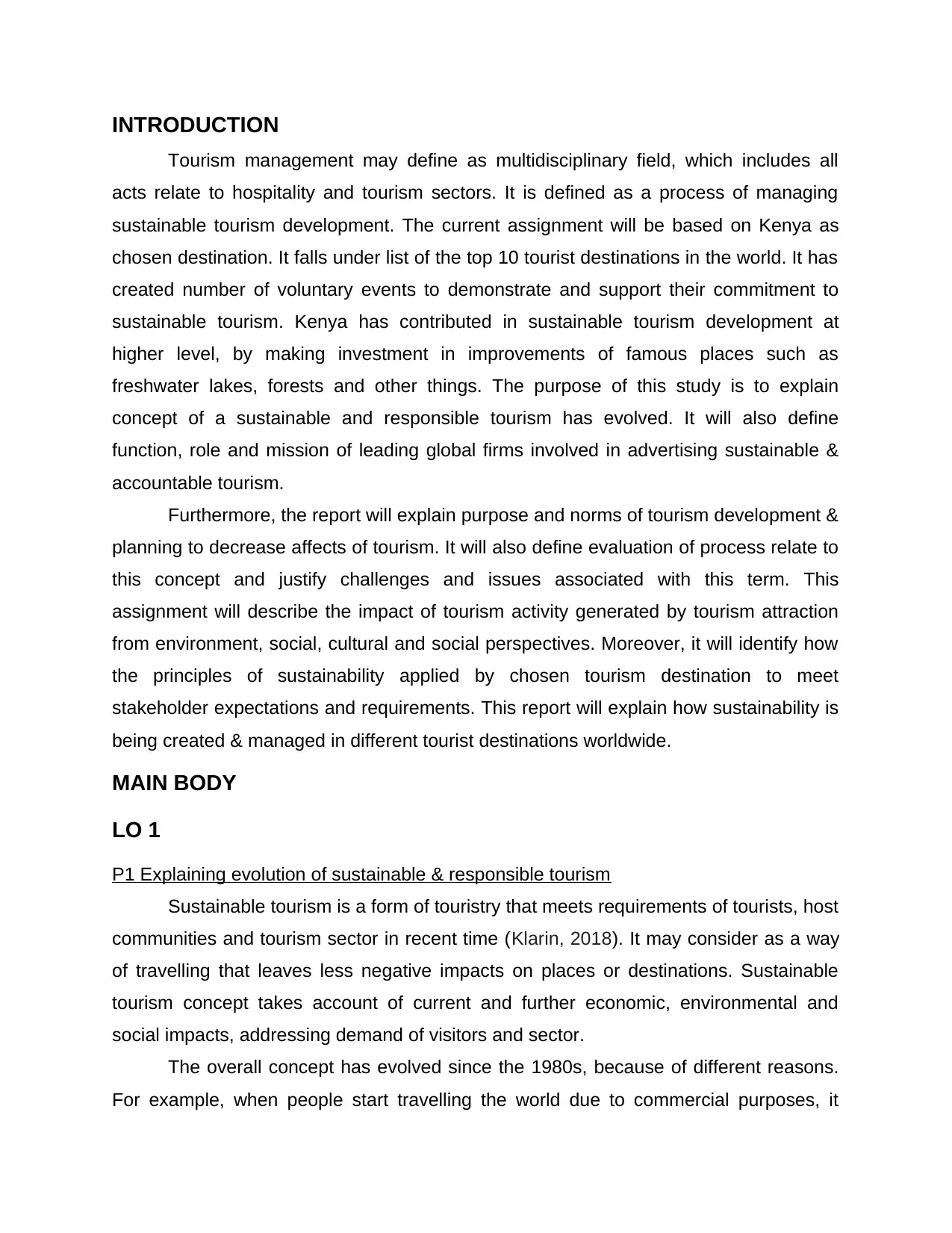
INTRODUCTION
Tourism management may define as multidisciplinary field, which includes all
acts relate to hospitality and tourism sectors. It is defined as a process of managing
sustainable tourism development. The current assignment will be based on Kenya as
chosen destination. It falls under list of the top 10 tourist destinations in the world. It has
created number of voluntary events to demonstrate and support their commitment to
sustainable tourism. Kenya has contributed in sustainable tourism development at
higher level, by making investment in improvements of famous places such as
freshwater lakes, forests and other things. The purpose of this study is to explain
concept of a sustainable and responsible tourism has evolved. It will also define
function, role and mission of leading global firms involved in advertising sustainable &
accountable tourism.
Furthermore, the report will explain purpose and norms of tourism development &
planning to decrease affects of tourism. It will also define evaluation of process relate to
this concept and justify challenges and issues associated with this term. This
assignment will describe the impact of tourism activity generated by tourism attraction
from environment, social, cultural and social perspectives. Moreover, it will identify how
the principles of sustainability applied by chosen tourism destination to meet
stakeholder expectations and requirements. This report will explain how sustainability is
being created & managed in different tourist destinations worldwide.
MAIN BODY
LO 1
P1 Explaining evolution of sustainable & responsible tourism
Sustainable tourism is a form of touristry that meets requirements of tourists, host
communities and tourism sector in recent time (Klarin, 2018). It may consider as a way
of travelling that leaves less negative impacts on places or destinations. Sustainable
tourism concept takes account of current and further economic, environmental and
social impacts, addressing demand of visitors and sector.
The overall concept has evolved since the 1980s, because of different reasons.
For example, when people start travelling the world due to commercial purposes, it
Tourism management may define as multidisciplinary field, which includes all
acts relate to hospitality and tourism sectors. It is defined as a process of managing
sustainable tourism development. The current assignment will be based on Kenya as
chosen destination. It falls under list of the top 10 tourist destinations in the world. It has
created number of voluntary events to demonstrate and support their commitment to
sustainable tourism. Kenya has contributed in sustainable tourism development at
higher level, by making investment in improvements of famous places such as
freshwater lakes, forests and other things. The purpose of this study is to explain
concept of a sustainable and responsible tourism has evolved. It will also define
function, role and mission of leading global firms involved in advertising sustainable &
accountable tourism.
Furthermore, the report will explain purpose and norms of tourism development &
planning to decrease affects of tourism. It will also define evaluation of process relate to
this concept and justify challenges and issues associated with this term. This
assignment will describe the impact of tourism activity generated by tourism attraction
from environment, social, cultural and social perspectives. Moreover, it will identify how
the principles of sustainability applied by chosen tourism destination to meet
stakeholder expectations and requirements. This report will explain how sustainability is
being created & managed in different tourist destinations worldwide.
MAIN BODY
LO 1
P1 Explaining evolution of sustainable & responsible tourism
Sustainable tourism is a form of touristry that meets requirements of tourists, host
communities and tourism sector in recent time (Klarin, 2018). It may consider as a way
of travelling that leaves less negative impacts on places or destinations. Sustainable
tourism concept takes account of current and further economic, environmental and
social impacts, addressing demand of visitors and sector.
The overall concept has evolved since the 1980s, because of different reasons.
For example, when people start travelling the world due to commercial purposes, it
⊘ This is a preview!⊘
Do you want full access?
Subscribe today to unlock all pages.

Trusted by 1+ million students worldwide
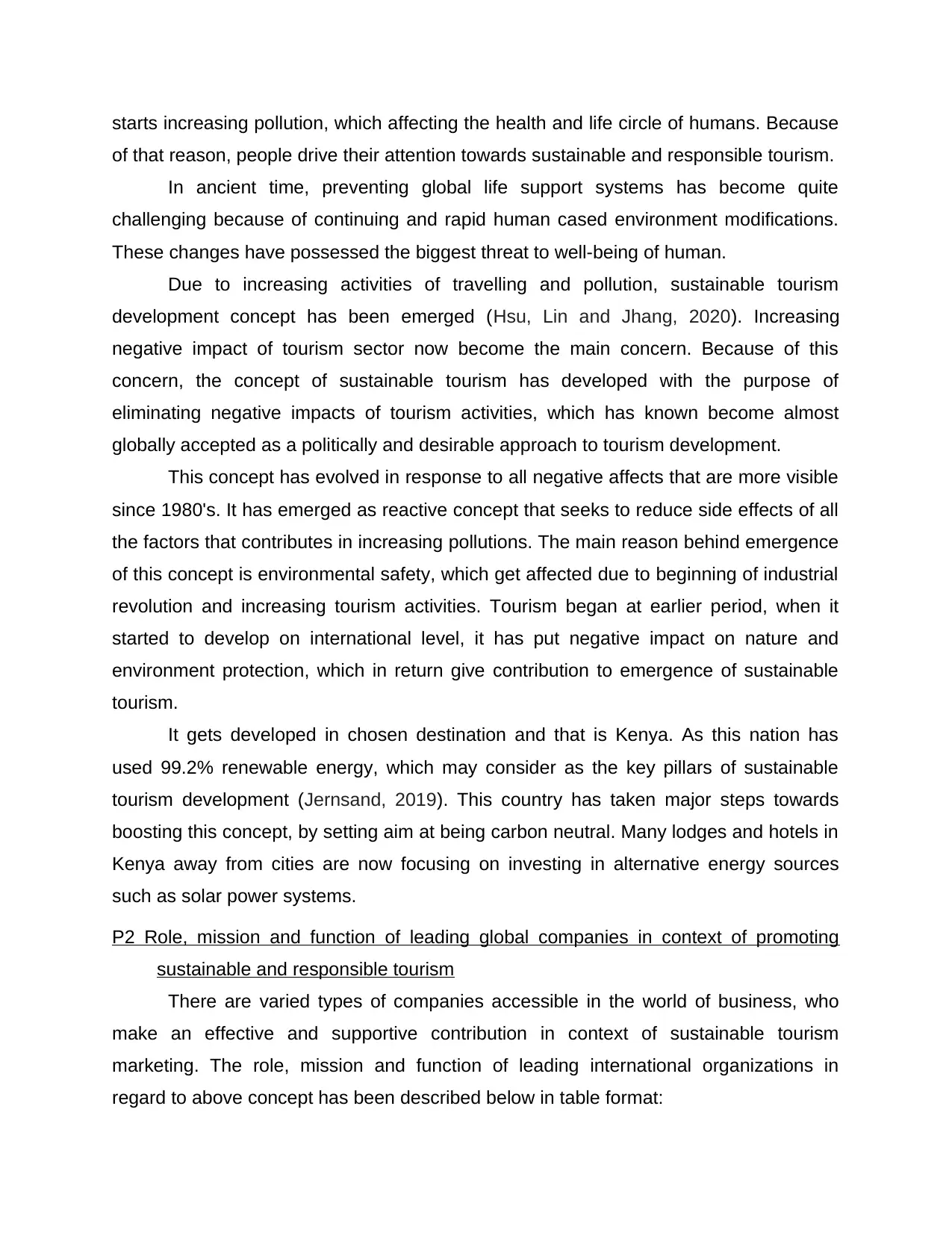
starts increasing pollution, which affecting the health and life circle of humans. Because
of that reason, people drive their attention towards sustainable and responsible tourism.
In ancient time, preventing global life support systems has become quite
challenging because of continuing and rapid human cased environment modifications.
These changes have possessed the biggest threat to well-being of human.
Due to increasing activities of travelling and pollution, sustainable tourism
development concept has been emerged (Hsu, Lin and Jhang, 2020). Increasing
negative impact of tourism sector now become the main concern. Because of this
concern, the concept of sustainable tourism has developed with the purpose of
eliminating negative impacts of tourism activities, which has known become almost
globally accepted as a politically and desirable approach to tourism development.
This concept has evolved in response to all negative affects that are more visible
since 1980's. It has emerged as reactive concept that seeks to reduce side effects of all
the factors that contributes in increasing pollutions. The main reason behind emergence
of this concept is environmental safety, which get affected due to beginning of industrial
revolution and increasing tourism activities. Tourism began at earlier period, when it
started to develop on international level, it has put negative impact on nature and
environment protection, which in return give contribution to emergence of sustainable
tourism.
It gets developed in chosen destination and that is Kenya. As this nation has
used 99.2% renewable energy, which may consider as the key pillars of sustainable
tourism development (Jernsand, 2019). This country has taken major steps towards
boosting this concept, by setting aim at being carbon neutral. Many lodges and hotels in
Kenya away from cities are now focusing on investing in alternative energy sources
such as solar power systems.
P2 Role, mission and function of leading global companies in context of promoting
sustainable and responsible tourism
There are varied types of companies accessible in the world of business, who
make an effective and supportive contribution in context of sustainable tourism
marketing. The role, mission and function of leading international organizations in
regard to above concept has been described below in table format:
of that reason, people drive their attention towards sustainable and responsible tourism.
In ancient time, preventing global life support systems has become quite
challenging because of continuing and rapid human cased environment modifications.
These changes have possessed the biggest threat to well-being of human.
Due to increasing activities of travelling and pollution, sustainable tourism
development concept has been emerged (Hsu, Lin and Jhang, 2020). Increasing
negative impact of tourism sector now become the main concern. Because of this
concern, the concept of sustainable tourism has developed with the purpose of
eliminating negative impacts of tourism activities, which has known become almost
globally accepted as a politically and desirable approach to tourism development.
This concept has evolved in response to all negative affects that are more visible
since 1980's. It has emerged as reactive concept that seeks to reduce side effects of all
the factors that contributes in increasing pollutions. The main reason behind emergence
of this concept is environmental safety, which get affected due to beginning of industrial
revolution and increasing tourism activities. Tourism began at earlier period, when it
started to develop on international level, it has put negative impact on nature and
environment protection, which in return give contribution to emergence of sustainable
tourism.
It gets developed in chosen destination and that is Kenya. As this nation has
used 99.2% renewable energy, which may consider as the key pillars of sustainable
tourism development (Jernsand, 2019). This country has taken major steps towards
boosting this concept, by setting aim at being carbon neutral. Many lodges and hotels in
Kenya away from cities are now focusing on investing in alternative energy sources
such as solar power systems.
P2 Role, mission and function of leading global companies in context of promoting
sustainable and responsible tourism
There are varied types of companies accessible in the world of business, who
make an effective and supportive contribution in context of sustainable tourism
marketing. The role, mission and function of leading international organizations in
regard to above concept has been described below in table format:
Paraphrase This Document
Need a fresh take? Get an instant paraphrase of this document with our AI Paraphraser
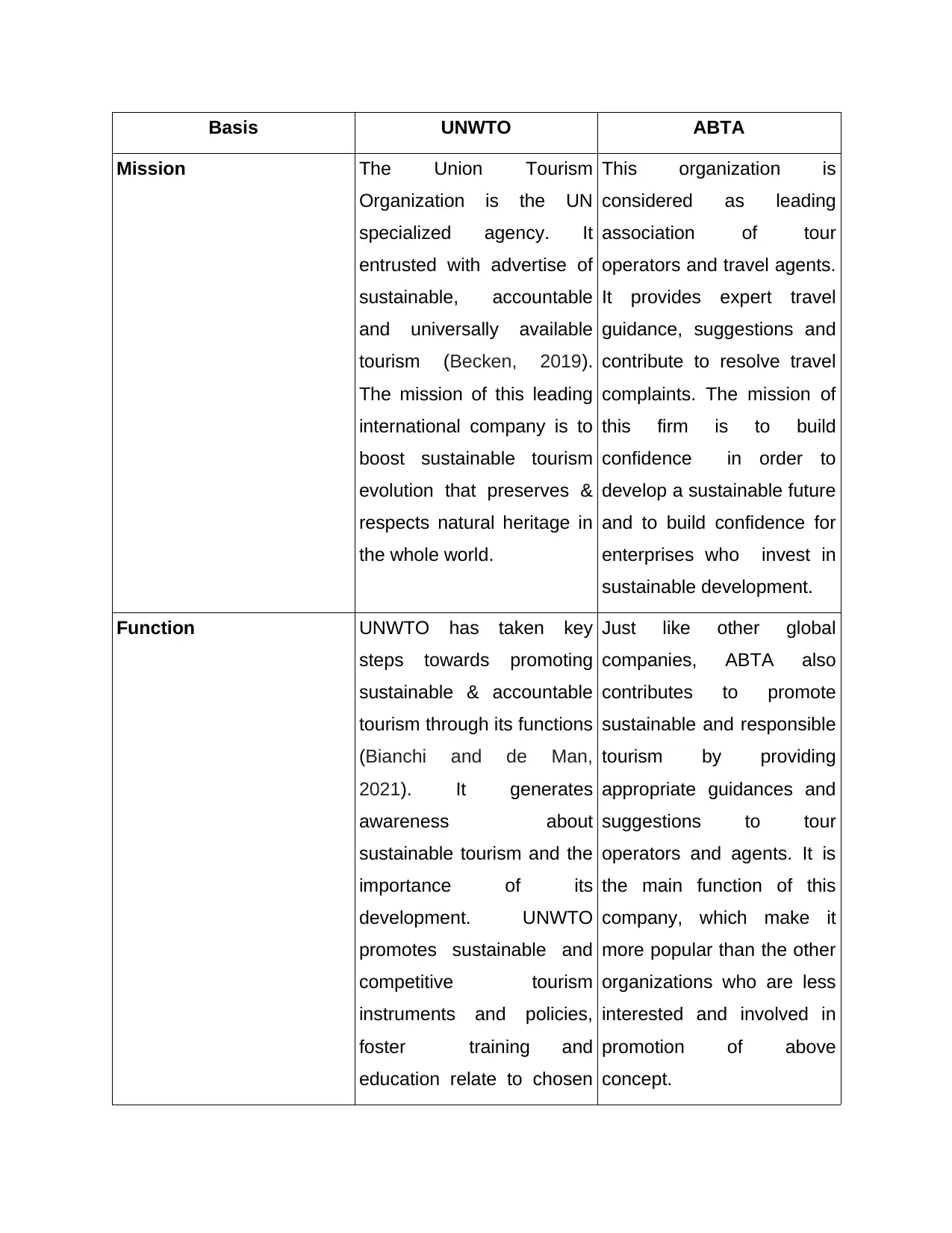
Basis UNWTO ABTA
Mission The Union Tourism
Organization is the UN
specialized agency. It
entrusted with advertise of
sustainable, accountable
and universally available
tourism (Becken, 2019).
The mission of this leading
international company is to
boost sustainable tourism
evolution that preserves &
respects natural heritage in
the whole world.
This organization is
considered as leading
association of tour
operators and travel agents.
It provides expert travel
guidance, suggestions and
contribute to resolve travel
complaints. The mission of
this firm is to build
confidence in order to
develop a sustainable future
and to build confidence for
enterprises who invest in
sustainable development.
Function UNWTO has taken key
steps towards promoting
sustainable & accountable
tourism through its functions
(Bianchi and de Man,
2021). It generates
awareness about
sustainable tourism and the
importance of its
development. UNWTO
promotes sustainable and
competitive tourism
instruments and policies,
foster training and
education relate to chosen
Just like other global
companies, ABTA also
contributes to promote
sustainable and responsible
tourism by providing
appropriate guidances and
suggestions to tour
operators and agents. It is
the main function of this
company, which make it
more popular than the other
organizations who are less
interested and involved in
promotion of above
concept.
Mission The Union Tourism
Organization is the UN
specialized agency. It
entrusted with advertise of
sustainable, accountable
and universally available
tourism (Becken, 2019).
The mission of this leading
international company is to
boost sustainable tourism
evolution that preserves &
respects natural heritage in
the whole world.
This organization is
considered as leading
association of tour
operators and travel agents.
It provides expert travel
guidance, suggestions and
contribute to resolve travel
complaints. The mission of
this firm is to build
confidence in order to
develop a sustainable future
and to build confidence for
enterprises who invest in
sustainable development.
Function UNWTO has taken key
steps towards promoting
sustainable & accountable
tourism through its functions
(Bianchi and de Man,
2021). It generates
awareness about
sustainable tourism and the
importance of its
development. UNWTO
promotes sustainable and
competitive tourism
instruments and policies,
foster training and
education relate to chosen
Just like other global
companies, ABTA also
contributes to promote
sustainable and responsible
tourism by providing
appropriate guidances and
suggestions to tour
operators and agents. It is
the main function of this
company, which make it
more popular than the other
organizations who are less
interested and involved in
promotion of above
concept.
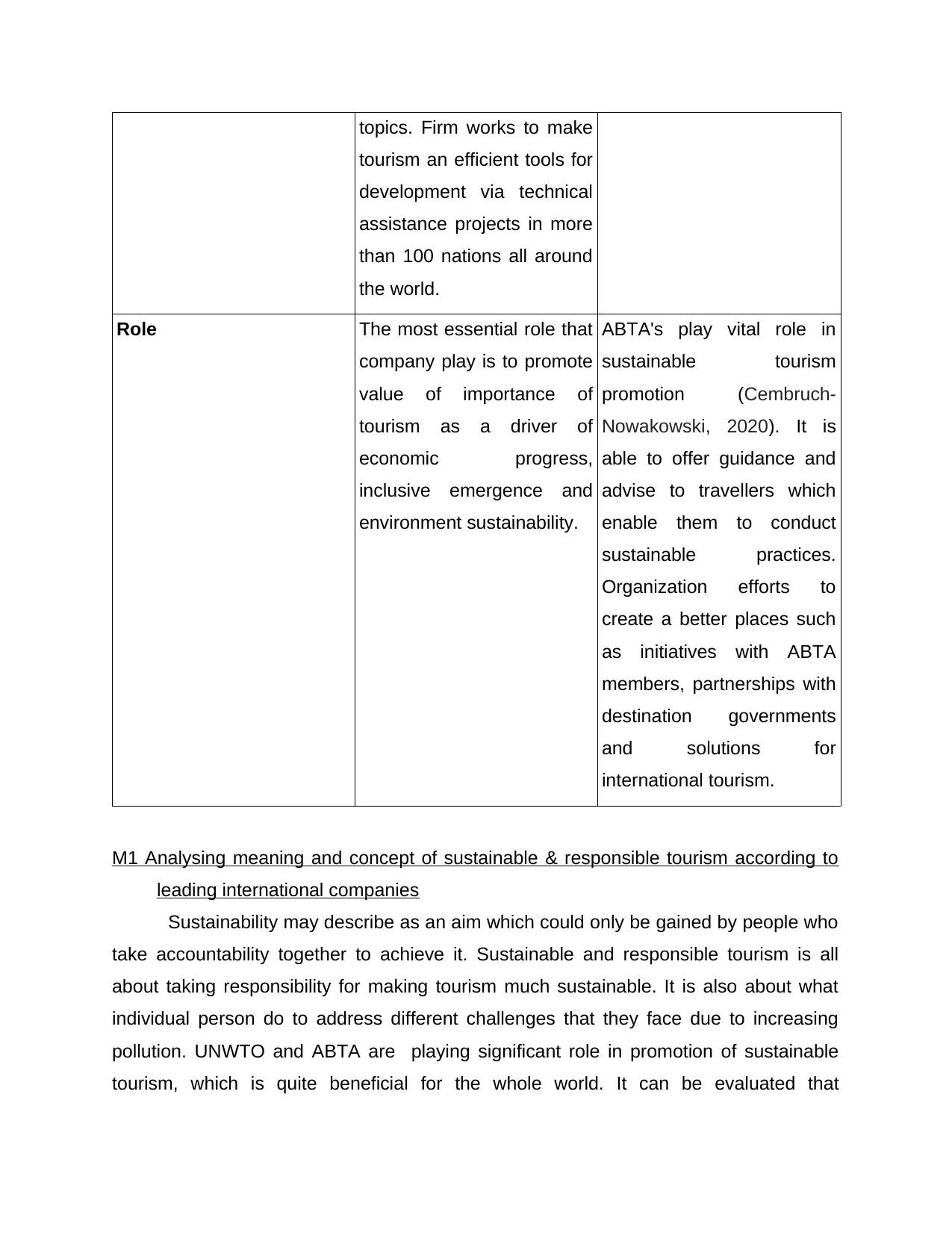
topics. Firm works to make
tourism an efficient tools for
development via technical
assistance projects in more
than 100 nations all around
the world.
Role The most essential role that
company play is to promote
value of importance of
tourism as a driver of
economic progress,
inclusive emergence and
environment sustainability.
ABTA's play vital role in
sustainable tourism
promotion (Cembruch-
Nowakowski, 2020). It is
able to offer guidance and
advise to travellers which
enable them to conduct
sustainable practices.
Organization efforts to
create a better places such
as initiatives with ABTA
members, partnerships with
destination governments
and solutions for
international tourism.
M1 Analysing meaning and concept of sustainable & responsible tourism according to
leading international companies
Sustainability may describe as an aim which could only be gained by people who
take accountability together to achieve it. Sustainable and responsible tourism is all
about taking responsibility for making tourism much sustainable. It is also about what
individual person do to address different challenges that they face due to increasing
pollution. UNWTO and ABTA are playing significant role in promotion of sustainable
tourism, which is quite beneficial for the whole world. It can be evaluated that
tourism an efficient tools for
development via technical
assistance projects in more
than 100 nations all around
the world.
Role The most essential role that
company play is to promote
value of importance of
tourism as a driver of
economic progress,
inclusive emergence and
environment sustainability.
ABTA's play vital role in
sustainable tourism
promotion (Cembruch-
Nowakowski, 2020). It is
able to offer guidance and
advise to travellers which
enable them to conduct
sustainable practices.
Organization efforts to
create a better places such
as initiatives with ABTA
members, partnerships with
destination governments
and solutions for
international tourism.
M1 Analysing meaning and concept of sustainable & responsible tourism according to
leading international companies
Sustainability may describe as an aim which could only be gained by people who
take accountability together to achieve it. Sustainable and responsible tourism is all
about taking responsibility for making tourism much sustainable. It is also about what
individual person do to address different challenges that they face due to increasing
pollution. UNWTO and ABTA are playing significant role in promotion of sustainable
tourism, which is quite beneficial for the whole world. It can be evaluated that
⊘ This is a preview!⊘
Do you want full access?
Subscribe today to unlock all pages.

Trusted by 1+ million students worldwide
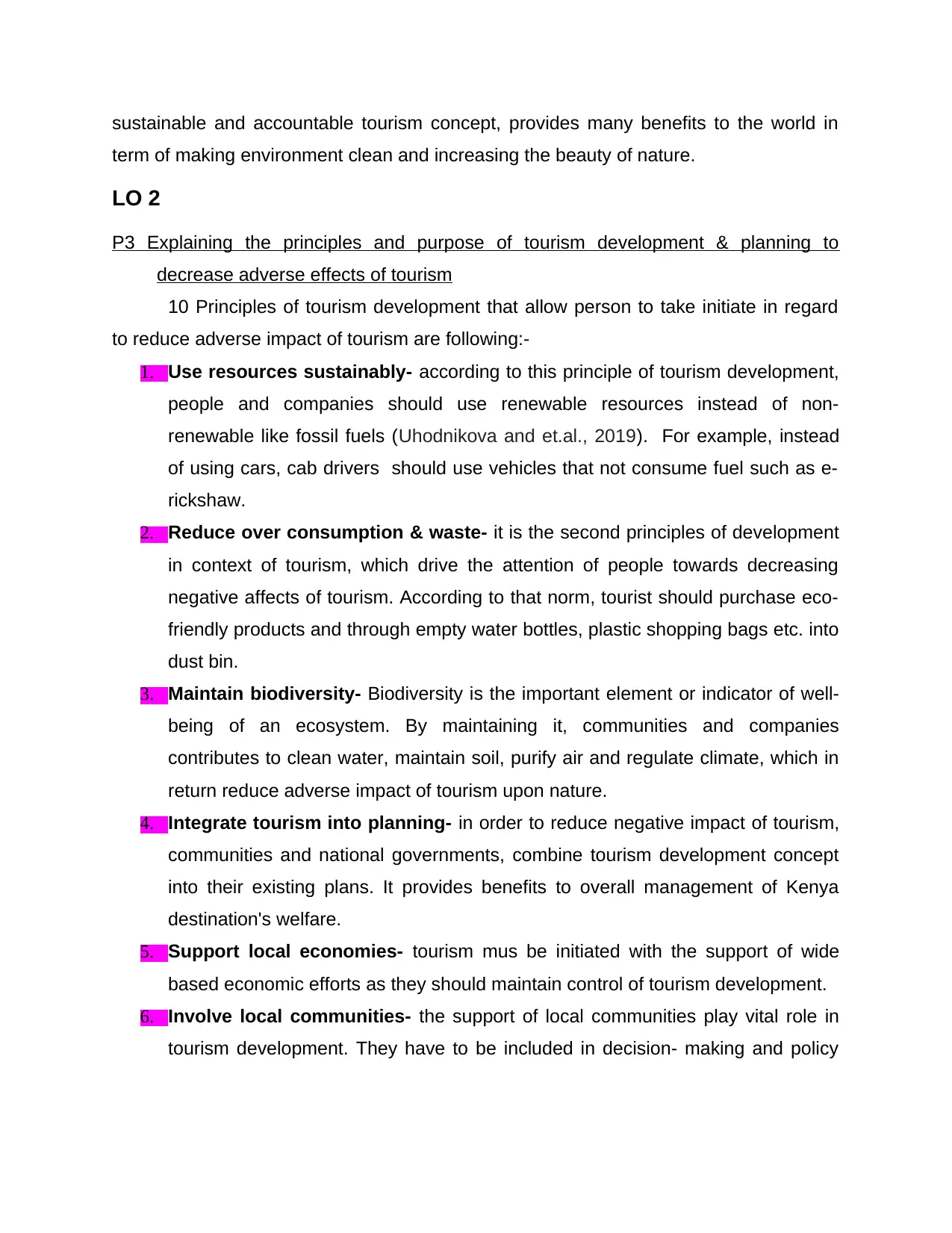
sustainable and accountable tourism concept, provides many benefits to the world in
term of making environment clean and increasing the beauty of nature.
LO 2
P3 Explaining the principles and purpose of tourism development & planning to
decrease adverse effects of tourism
10 Principles of tourism development that allow person to take initiate in regard
to reduce adverse impact of tourism are following:-
1. Use resources sustainably- according to this principle of tourism development,
people and companies should use renewable resources instead of non-
renewable like fossil fuels (Uhodnikova and et.al., 2019). For example, instead
of using cars, cab drivers should use vehicles that not consume fuel such as e-
rickshaw.
2. Reduce over consumption & waste- it is the second principles of development
in context of tourism, which drive the attention of people towards decreasing
negative affects of tourism. According to that norm, tourist should purchase eco-
friendly products and through empty water bottles, plastic shopping bags etc. into
dust bin.
3. Maintain biodiversity- Biodiversity is the important element or indicator of well-
being of an ecosystem. By maintaining it, communities and companies
contributes to clean water, maintain soil, purify air and regulate climate, which in
return reduce adverse impact of tourism upon nature.
4. Integrate tourism into planning- in order to reduce negative impact of tourism,
communities and national governments, combine tourism development concept
into their existing plans. It provides benefits to overall management of Kenya
destination's welfare.
5. Support local economies- tourism mus be initiated with the support of wide
based economic efforts as they should maintain control of tourism development.
6. Involve local communities- the support of local communities play vital role in
tourism development. They have to be included in decision- making and policy
term of making environment clean and increasing the beauty of nature.
LO 2
P3 Explaining the principles and purpose of tourism development & planning to
decrease adverse effects of tourism
10 Principles of tourism development that allow person to take initiate in regard
to reduce adverse impact of tourism are following:-
1. Use resources sustainably- according to this principle of tourism development,
people and companies should use renewable resources instead of non-
renewable like fossil fuels (Uhodnikova and et.al., 2019). For example, instead
of using cars, cab drivers should use vehicles that not consume fuel such as e-
rickshaw.
2. Reduce over consumption & waste- it is the second principles of development
in context of tourism, which drive the attention of people towards decreasing
negative affects of tourism. According to that norm, tourist should purchase eco-
friendly products and through empty water bottles, plastic shopping bags etc. into
dust bin.
3. Maintain biodiversity- Biodiversity is the important element or indicator of well-
being of an ecosystem. By maintaining it, communities and companies
contributes to clean water, maintain soil, purify air and regulate climate, which in
return reduce adverse impact of tourism upon nature.
4. Integrate tourism into planning- in order to reduce negative impact of tourism,
communities and national governments, combine tourism development concept
into their existing plans. It provides benefits to overall management of Kenya
destination's welfare.
5. Support local economies- tourism mus be initiated with the support of wide
based economic efforts as they should maintain control of tourism development.
6. Involve local communities- the support of local communities play vital role in
tourism development. They have to be included in decision- making and policy
Paraphrase This Document
Need a fresh take? Get an instant paraphrase of this document with our AI Paraphraser

formulation so that it may enhance confidence and trust of local people on
tourism sector.
7. Consult public and stakeholders- according to the seven principles,
governments within Kenya nation, should make consultation about sustainable
tourism development with key stakeholders and local people. As it enable them
to obtain effective ideas.
8. Train workers- Tour operators and leading global companies like UNWTO
should develop training programmes. It helps to enhance knowledge and
competences of workers in context of providing better services.
9. Provide quality employment- tourism sector should offer the best employment
opportunities to local people, which enables them to contribute to tourism
development (Eslami and et,al., 2019). Community residents are able to provide
quality service to tourist, which in return increase the level of industry
productivity.
10. Establish code of practice- according to this norm, code of practice must be
developed for tourism at national, local, regional and international level.
Appropriate guidelines and directions affect the way tourism operations should
be conducted.
Tourism planning role to minimize negative impact of water pollution in Kenya
due to tourism-
Kenya is one of the most popular tourist destinations in the world, it provides the
best experience to tourist. But due over-tourism, this nation faces environmental
challenges such as water pollution (Blázquez-Salom and et.al., 2019). It may overcome
by making effective tourism plan. Before making any plan, government within Kenya
may begin to think about ways that used to overcome negative impact tourism on water.
Within chosen destination, they may contribute to put a just bin nearby lakes and places
where number of tourist visiting is high.
Most of the tourist's throw empty cans and bottles near rivers or lakes, which
contaminate water. Kenya may overcome this problem by putting dust bin and
generating awareness about issue posed by water pollution.
Purpose of tourism development and planning-
tourism sector.
7. Consult public and stakeholders- according to the seven principles,
governments within Kenya nation, should make consultation about sustainable
tourism development with key stakeholders and local people. As it enable them
to obtain effective ideas.
8. Train workers- Tour operators and leading global companies like UNWTO
should develop training programmes. It helps to enhance knowledge and
competences of workers in context of providing better services.
9. Provide quality employment- tourism sector should offer the best employment
opportunities to local people, which enables them to contribute to tourism
development (Eslami and et,al., 2019). Community residents are able to provide
quality service to tourist, which in return increase the level of industry
productivity.
10. Establish code of practice- according to this norm, code of practice must be
developed for tourism at national, local, regional and international level.
Appropriate guidelines and directions affect the way tourism operations should
be conducted.
Tourism planning role to minimize negative impact of water pollution in Kenya
due to tourism-
Kenya is one of the most popular tourist destinations in the world, it provides the
best experience to tourist. But due over-tourism, this nation faces environmental
challenges such as water pollution (Blázquez-Salom and et.al., 2019). It may overcome
by making effective tourism plan. Before making any plan, government within Kenya
may begin to think about ways that used to overcome negative impact tourism on water.
Within chosen destination, they may contribute to put a just bin nearby lakes and places
where number of tourist visiting is high.
Most of the tourist's throw empty cans and bottles near rivers or lakes, which
contaminate water. Kenya may overcome this problem by putting dust bin and
generating awareness about issue posed by water pollution.
Purpose of tourism development and planning-

The main aim of tourism development & planning is to increase employment
opportunities and maximize revenue of economy. The purpose of this procedure is to
reduce impacts of tourism by making effective plans and taking contribution of local
people.
P4 Evaluating procedure of tourism development and planning and associated
problems as well as challenges
Positive impact-
As discussed above planning and development of tourism encompasses varied
stages and principles that help to overcome negative impact of over-tourism in Kenya
(Afthanorhan, Awang and Fazella, 2017). Tourism development & planning process
puts positive impact upon Kenyaas chosen destination. It helps to make environment
sustainable, increase new job opportunities, and revenues as well, which is quite
important to boost the economic level.
Negative impact-
The process of tourism development & planning affect in negative manner. Its
impact is not limited in initial consumption of services and products, but also increase
through sum of secondary and direct impact created by additional tourism expenditure
within Kenya. The overall procedure consume a lot of time and efforts as well as money.
In order to develop an effective plan that contribute in sustainable tourism development,
government needs to invest maximum amount.
Challenges of tourism planning-
In the process of tourism planning, the biggest challenges or issues are high
cost, lack of expertise in tourism advertising programme, time constraint, lack of
awarenesses about tourism development benefits etc. Planning relate to this concept it
actually very important and beneficial for Kenya, but due to above barriers the entire act
get affected. Furthermore, lack of comprehending among stakeholders such as
government, local communities and others to develop and plan tourism also bring
challenges.
M2 Critically evaluating varied approaches to tourism development and planning for
successfully achieving sustainable objectives
Holistic approach-
opportunities and maximize revenue of economy. The purpose of this procedure is to
reduce impacts of tourism by making effective plans and taking contribution of local
people.
P4 Evaluating procedure of tourism development and planning and associated
problems as well as challenges
Positive impact-
As discussed above planning and development of tourism encompasses varied
stages and principles that help to overcome negative impact of over-tourism in Kenya
(Afthanorhan, Awang and Fazella, 2017). Tourism development & planning process
puts positive impact upon Kenyaas chosen destination. It helps to make environment
sustainable, increase new job opportunities, and revenues as well, which is quite
important to boost the economic level.
Negative impact-
The process of tourism development & planning affect in negative manner. Its
impact is not limited in initial consumption of services and products, but also increase
through sum of secondary and direct impact created by additional tourism expenditure
within Kenya. The overall procedure consume a lot of time and efforts as well as money.
In order to develop an effective plan that contribute in sustainable tourism development,
government needs to invest maximum amount.
Challenges of tourism planning-
In the process of tourism planning, the biggest challenges or issues are high
cost, lack of expertise in tourism advertising programme, time constraint, lack of
awarenesses about tourism development benefits etc. Planning relate to this concept it
actually very important and beneficial for Kenya, but due to above barriers the entire act
get affected. Furthermore, lack of comprehending among stakeholders such as
government, local communities and others to develop and plan tourism also bring
challenges.
M2 Critically evaluating varied approaches to tourism development and planning for
successfully achieving sustainable objectives
Holistic approach-
⊘ This is a preview!⊘
Do you want full access?
Subscribe today to unlock all pages.

Trusted by 1+ million students worldwide
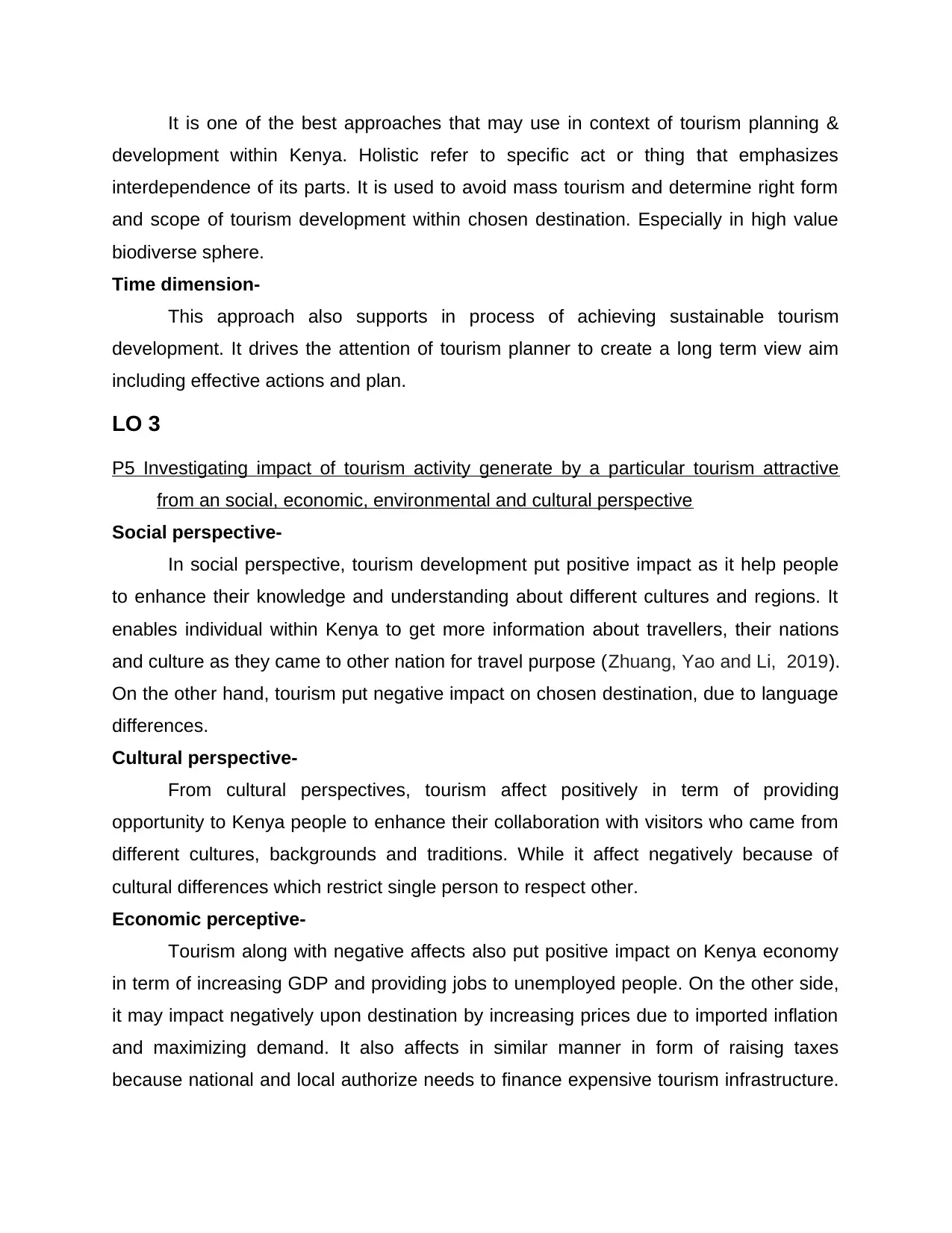
It is one of the best approaches that may use in context of tourism planning &
development within Kenya. Holistic refer to specific act or thing that emphasizes
interdependence of its parts. It is used to avoid mass tourism and determine right form
and scope of tourism development within chosen destination. Especially in high value
biodiverse sphere.
Time dimension-
This approach also supports in process of achieving sustainable tourism
development. It drives the attention of tourism planner to create a long term view aim
including effective actions and plan.
LO 3
P5 Investigating impact of tourism activity generate by a particular tourism attractive
from an social, economic, environmental and cultural perspective
Social perspective-
In social perspective, tourism development put positive impact as it help people
to enhance their knowledge and understanding about different cultures and regions. It
enables individual within Kenya to get more information about travellers, their nations
and culture as they came to other nation for travel purpose (Zhuang, Yao and Li, 2019).
On the other hand, tourism put negative impact on chosen destination, due to language
differences.
Cultural perspective-
From cultural perspectives, tourism affect positively in term of providing
opportunity to Kenya people to enhance their collaboration with visitors who came from
different cultures, backgrounds and traditions. While it affect negatively because of
cultural differences which restrict single person to respect other.
Economic perceptive-
Tourism along with negative affects also put positive impact on Kenya economy
in term of increasing GDP and providing jobs to unemployed people. On the other side,
it may impact negatively upon destination by increasing prices due to imported inflation
and maximizing demand. It also affects in similar manner in form of raising taxes
because national and local authorize needs to finance expensive tourism infrastructure.
development within Kenya. Holistic refer to specific act or thing that emphasizes
interdependence of its parts. It is used to avoid mass tourism and determine right form
and scope of tourism development within chosen destination. Especially in high value
biodiverse sphere.
Time dimension-
This approach also supports in process of achieving sustainable tourism
development. It drives the attention of tourism planner to create a long term view aim
including effective actions and plan.
LO 3
P5 Investigating impact of tourism activity generate by a particular tourism attractive
from an social, economic, environmental and cultural perspective
Social perspective-
In social perspective, tourism development put positive impact as it help people
to enhance their knowledge and understanding about different cultures and regions. It
enables individual within Kenya to get more information about travellers, their nations
and culture as they came to other nation for travel purpose (Zhuang, Yao and Li, 2019).
On the other hand, tourism put negative impact on chosen destination, due to language
differences.
Cultural perspective-
From cultural perspectives, tourism affect positively in term of providing
opportunity to Kenya people to enhance their collaboration with visitors who came from
different cultures, backgrounds and traditions. While it affect negatively because of
cultural differences which restrict single person to respect other.
Economic perceptive-
Tourism along with negative affects also put positive impact on Kenya economy
in term of increasing GDP and providing jobs to unemployed people. On the other side,
it may impact negatively upon destination by increasing prices due to imported inflation
and maximizing demand. It also affects in similar manner in form of raising taxes
because national and local authorize needs to finance expensive tourism infrastructure.
Paraphrase This Document
Need a fresh take? Get an instant paraphrase of this document with our AI Paraphraser
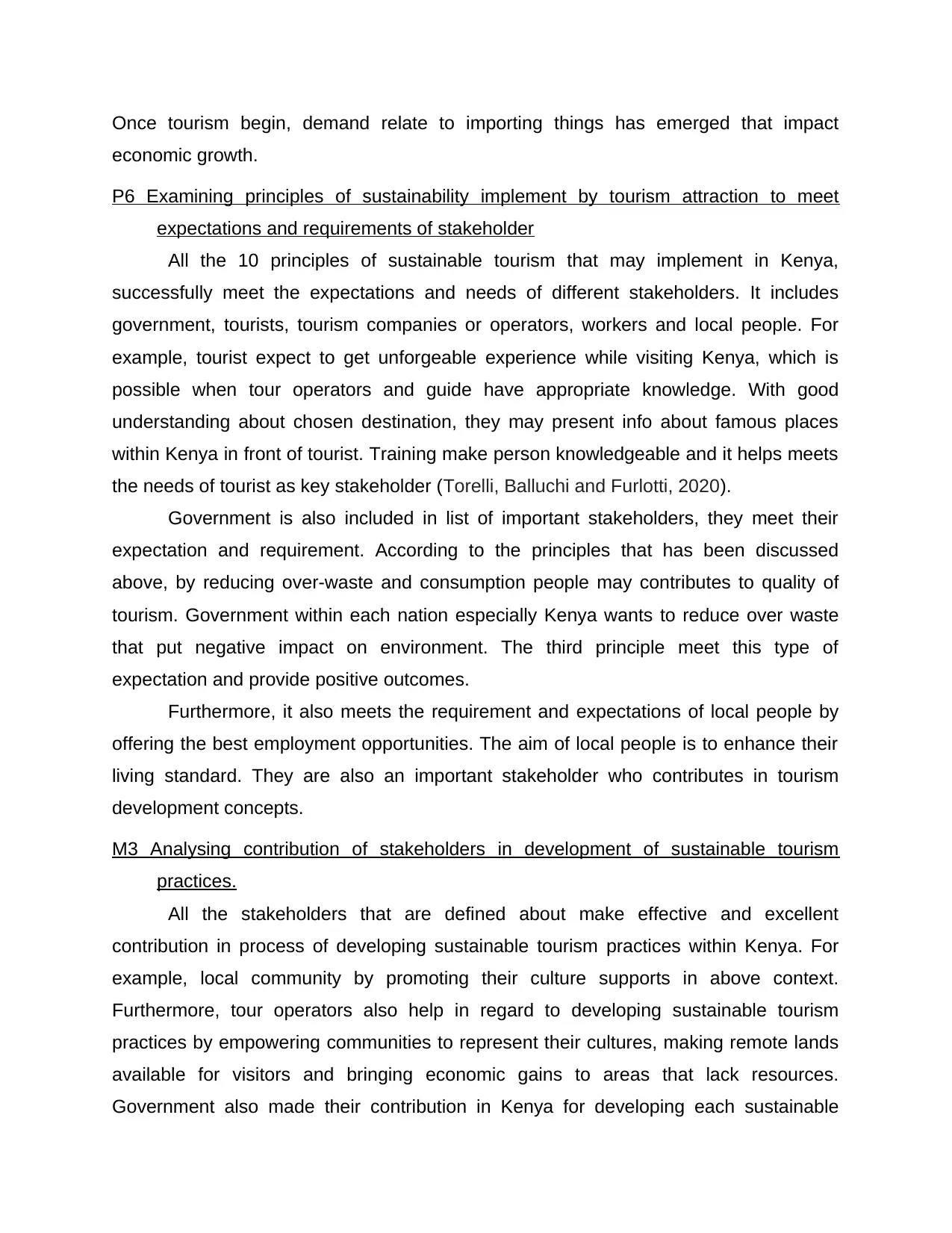
Once tourism begin, demand relate to importing things has emerged that impact
economic growth.
P6 Examining principles of sustainability implement by tourism attraction to meet
expectations and requirements of stakeholder
All the 10 principles of sustainable tourism that may implement in Kenya,
successfully meet the expectations and needs of different stakeholders. It includes
government, tourists, tourism companies or operators, workers and local people. For
example, tourist expect to get unforgeable experience while visiting Kenya, which is
possible when tour operators and guide have appropriate knowledge. With good
understanding about chosen destination, they may present info about famous places
within Kenya in front of tourist. Training make person knowledgeable and it helps meets
the needs of tourist as key stakeholder (Torelli, Balluchi and Furlotti, 2020).
Government is also included in list of important stakeholders, they meet their
expectation and requirement. According to the principles that has been discussed
above, by reducing over-waste and consumption people may contributes to quality of
tourism. Government within each nation especially Kenya wants to reduce over waste
that put negative impact on environment. The third principle meet this type of
expectation and provide positive outcomes.
Furthermore, it also meets the requirement and expectations of local people by
offering the best employment opportunities. The aim of local people is to enhance their
living standard. They are also an important stakeholder who contributes in tourism
development concepts.
M3 Analysing contribution of stakeholders in development of sustainable tourism
practices.
All the stakeholders that are defined about make effective and excellent
contribution in process of developing sustainable tourism practices within Kenya. For
example, local community by promoting their culture supports in above context.
Furthermore, tour operators also help in regard to developing sustainable tourism
practices by empowering communities to represent their cultures, making remote lands
available for visitors and bringing economic gains to areas that lack resources.
Government also made their contribution in Kenya for developing each sustainable
economic growth.
P6 Examining principles of sustainability implement by tourism attraction to meet
expectations and requirements of stakeholder
All the 10 principles of sustainable tourism that may implement in Kenya,
successfully meet the expectations and needs of different stakeholders. It includes
government, tourists, tourism companies or operators, workers and local people. For
example, tourist expect to get unforgeable experience while visiting Kenya, which is
possible when tour operators and guide have appropriate knowledge. With good
understanding about chosen destination, they may present info about famous places
within Kenya in front of tourist. Training make person knowledgeable and it helps meets
the needs of tourist as key stakeholder (Torelli, Balluchi and Furlotti, 2020).
Government is also included in list of important stakeholders, they meet their
expectation and requirement. According to the principles that has been discussed
above, by reducing over-waste and consumption people may contributes to quality of
tourism. Government within each nation especially Kenya wants to reduce over waste
that put negative impact on environment. The third principle meet this type of
expectation and provide positive outcomes.
Furthermore, it also meets the requirement and expectations of local people by
offering the best employment opportunities. The aim of local people is to enhance their
living standard. They are also an important stakeholder who contributes in tourism
development concepts.
M3 Analysing contribution of stakeholders in development of sustainable tourism
practices.
All the stakeholders that are defined about make effective and excellent
contribution in process of developing sustainable tourism practices within Kenya. For
example, local community by promoting their culture supports in above context.
Furthermore, tour operators also help in regard to developing sustainable tourism
practices by empowering communities to represent their cultures, making remote lands
available for visitors and bringing economic gains to areas that lack resources.
Government also made their contribution in Kenya for developing each sustainable

tourism practice, by developing policies and investing into improvements of parks,
heritages and other tourist places.
LO 4
P7 Evaluating sustainability is being created and managed in range of tourist
destinations worldwide
There are varied methods, approaches, techniques and ways available in the
business world that local and national authorities used to create and successfully
manage sustainability in range of destinations. For example, sustainability is created in
Kenya by using recyclable materials. It is one of the best approaches, people can do to
promote sustainability in this nation. Iceland is also considered as one of the most
popular tourist destinations in the world, where sustainability is being created and
managed by using natural geothermal resources for electricity and heat production
(Spittler and et.al., 2020). It is used to prevent destination's from ocean pollution, it
helps in regard to sustainable fishing activities.
Along with above examples, there are more examples accessible that define the
creation of sustainability in tourist destinations. For example, Netherlands also created
and managed sustainability by reducing 70% of carbon emissions as well as air
pollution. More than 20 years, it has had a national environment strategy in place. It
takes major steps towards sustainability, by cleaning up rivers and improving waste
management.
By focusing on sanitation, habitat conservation and biodiversity, Finland as
another tourist destination has created sustainability and managed it systematically. It
provides benefits to this location in term of increasing its popularity worldwide that help
to gain attention of more visitors.
M4 Critical examining success or failure of sustainable management applied in context
of different tourist destinations worldwide
Netherlands, Island and other nations or destinations are accessible in the world
who get success in context of sustainable management, which in return generate GDP
and increase tourist base. They get success by making an effective plans and conduct
heritages and other tourist places.
LO 4
P7 Evaluating sustainability is being created and managed in range of tourist
destinations worldwide
There are varied methods, approaches, techniques and ways available in the
business world that local and national authorities used to create and successfully
manage sustainability in range of destinations. For example, sustainability is created in
Kenya by using recyclable materials. It is one of the best approaches, people can do to
promote sustainability in this nation. Iceland is also considered as one of the most
popular tourist destinations in the world, where sustainability is being created and
managed by using natural geothermal resources for electricity and heat production
(Spittler and et.al., 2020). It is used to prevent destination's from ocean pollution, it
helps in regard to sustainable fishing activities.
Along with above examples, there are more examples accessible that define the
creation of sustainability in tourist destinations. For example, Netherlands also created
and managed sustainability by reducing 70% of carbon emissions as well as air
pollution. More than 20 years, it has had a national environment strategy in place. It
takes major steps towards sustainability, by cleaning up rivers and improving waste
management.
By focusing on sanitation, habitat conservation and biodiversity, Finland as
another tourist destination has created sustainability and managed it systematically. It
provides benefits to this location in term of increasing its popularity worldwide that help
to gain attention of more visitors.
M4 Critical examining success or failure of sustainable management applied in context
of different tourist destinations worldwide
Netherlands, Island and other nations or destinations are accessible in the world
who get success in context of sustainable management, which in return generate GDP
and increase tourist base. They get success by making an effective plans and conduct
⊘ This is a preview!⊘
Do you want full access?
Subscribe today to unlock all pages.

Trusted by 1+ million students worldwide
1 out of 15
Related Documents
Your All-in-One AI-Powered Toolkit for Academic Success.
+13062052269
info@desklib.com
Available 24*7 on WhatsApp / Email
![[object Object]](/_next/static/media/star-bottom.7253800d.svg)
Unlock your academic potential
Copyright © 2020–2025 A2Z Services. All Rights Reserved. Developed and managed by ZUCOL.




